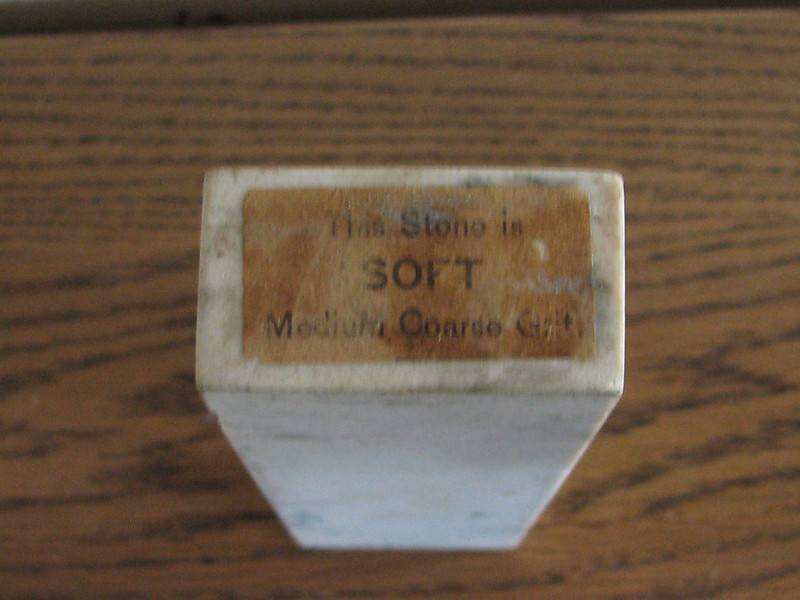



Here is a couple of group photos of the Washitas I have tried, from top to bottom in the first picture: 1) Lily White from Ebay, got it luckily with end label (which the seller forget to photograph for some reason), saying its Soft, fast cutting grit - Oli already wrote a report about it earlier in this thread, its one of the very best natural stones for edge sharpening I have ever tried, I really, really love it! 2) The Tomahawk brand stone 3) A very hard and dense stone I bought more or less incidentaly on Ebay along with some coticules which were my main target that time, it was actually the stone which turned my attention towards Washitas...It took ages until I got it completely flat with my old, worn atoma, but it was really sweet, with a wide range and provided lovely edges, I sold to a good friend of mine who liked it similarly as I did, its the second best edge finisher after the LW mentioned above 4) an Ebay stone which has been selected by the seller as the fastest of a batch he had for sale, but it was actually pretty slow, at least compared to any other Washita on this picture, it was simply nothing special and I sold it 5) the WWD
But guys, please, tell me one thing! We all know that Washitas are generally known as oilstones, but can also by used with water, although most people prefer to use them with oil...But can somebody explain me why? Or better, I would like to hear the opinions of the particular people why they are using them with oil rather than with water...
Of course, I know that the surface can be burnished pretty easily and quickly, especially in the harder and finer specimens, so that the stone would then stop cutting and become super slow...or do almost nothing...And oil should help to keep the stone cutting...
I am also aware that oil should prevent the stone surface from clogging with the swarf particles which might again decrease its speed and efficiency...So, what I am typically doing is raising a little bit of slurry using my worn Atoma 600...I know that I have tried only a little fraction of Washitas as compared to some experienced guys like
@cotedupy ,
@Desert Rat ,
@stringer ,
@Legion74 and others, barely those 5 pieces above, but IMO, it was a relatively representative selection for what Washitas can offer, ranging from very soft and fast stones with a low SG up to very hard and fine stones...
And I can only say that every single stone had a totally lovely feedback when used with that little of generated slurry...Even the lower quality ones which had somewhat inconsistent grit and feeled rather unpleasant when used with oil...And of course, every single stone I have tried this way worked definitely faster than it worked with oil...One may argue - but this way you will wear down the stone quickly! Yeah, that would certainly be true with something like some softer coticule where one would just burn money this way...But is that really an issue with something THAT hard and rather cheap like Washitas? Especially when the amount of material which gets lost is really minimal, using for instance that worn Atoma 600 (and actually, when working with such fast and softer stones like the WWD, creating of slurry is not necessary at all, its fully sufficient to just refresh the surface lightly)? I don't think so, to be honest...And raising that little amount of slurry solves also that eventual clogging problem (which, all the more, is maybe not that serious, when I once compared the WWD stone when used with water and then with oil, there was optically a much more significant clogging when used with the latter) as you always get some fresh grit which ensures that the stone will cut quickly...
And one can always use the stone with just water to finish the work and refine the edges...I typically do this for instance with my beloved LW and get really excellent edges this way...And of course, the water management is also easier with water, using a sprinkler with water, at least for me...And you don't get that bloody slippery surface with water as if you use the stone with oil...
Simply - I don't see there any significant arguments against using Washitas with just water (of course, with a little of generated slurry), but, on the other hand, I see there some advantages! But would really appreciate everybody's input to this topic, as I mentioned, I am far from being an experienced Washita user...
And last but not least, I would like to thank publicly
@cotedupy and
@ethompson for their kindness and help with obtaining some of the above mentioned stones and even saving me money for custom duties - the WWD seller didn't ship outside US at all, but Edward kindly offered to forward the stone to me, the same applies for Oli who even forwarded me two stones and, moreover, shared with me a lot of his knowledge about Washitas!



























































